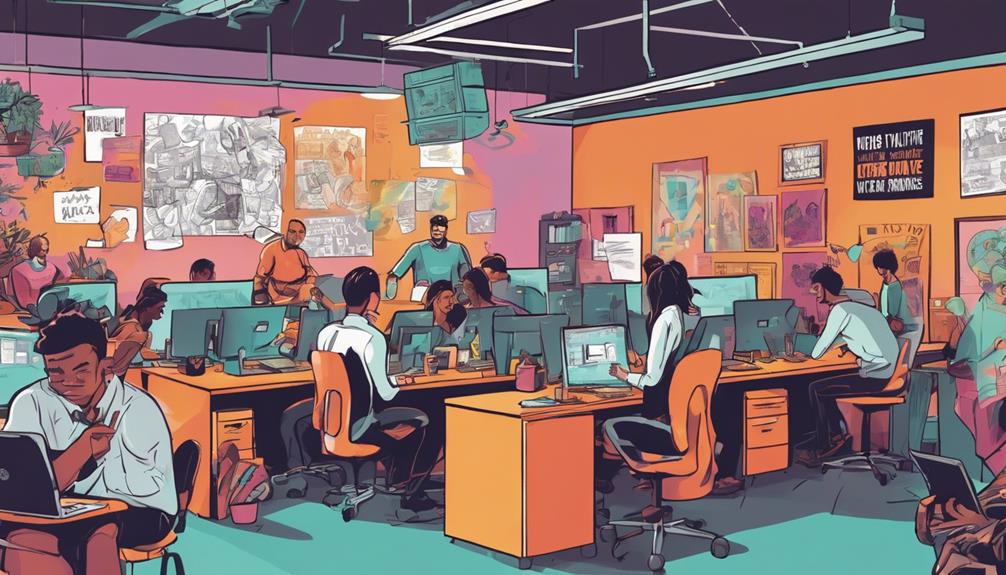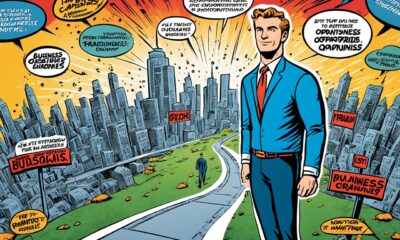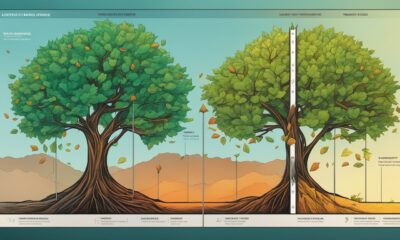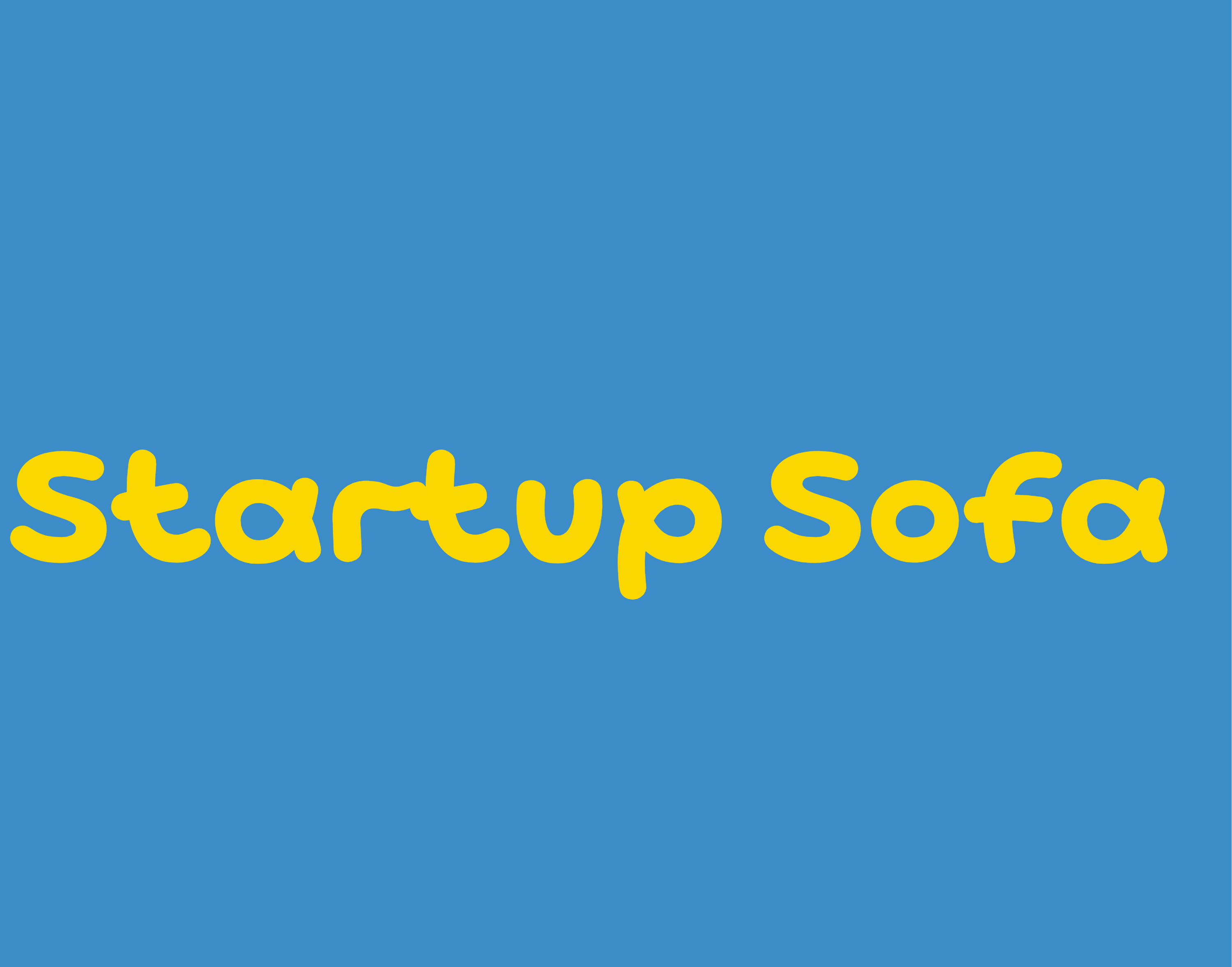Growing a Business
From Startup to Sensation: Grubhub's Journey
Witness how Grubhub transformed from a simple startup to a food delivery powerhouse, and discover the challenges that shaped its remarkable journey.

Grubhub's journey from a modest startup to a food delivery sensation showcases how innovation drives success. Founded in 2002 by Mike Evans and Matt Maloney, it started by listing Chicago restaurants lacking delivery options. Its shift to a commission-based model and the introduction of online ordering led to impressive growth. Key milestones include going public in 2014 and expanding into major cities. Along the way, Grubhub faced challenges, including relationship strains with partner restaurants. The company's commitment to improving work conditions and sustainability shows it values people alongside profits. Continue exploring to uncover more about Grubhub's evolution and future.
Key Takeaways
- Grubhub was founded in 2002 by Mike Evans and Matt Maloney, addressing the need for efficient food delivery services.
- The company shifted from premium listings to a commission-based model, significantly boosting revenue and order volume.
- Key expansion milestones included acquiring CampusFood and Seamless, and going public in April 2014, enhancing market presence.
- Challenges arose from strained relationships with restaurants and employee burnout, highlighting the importance of maintaining company culture.
Origins of Grubhub
Grubhub started from a simple idea born out of frustration during a commute, transforming into a platform that revolutionized how you order food online.
Co-founder Mike Evans faced a challenge in 2002 and decided to map Chicago restaurants while coding. Initially, the site was just a list of eateries, lacking delivery services.
The first revenue came when a restaurant paid $140 for a premium listing, and Evans and co-founder Matt Maloney gathered menus door-to-door. They soon shifted to a commission-based model, which greatly boosted earnings.
When online ordering was introduced, orders tripled, and the company raked in $20,000 within the first month.
This early growth laid the foundation for Grubhub's future success and expansion.
Early Business Model

The early business model focused on monetizing restaurant listings through premium fees, paving the way for a more lucrative commission-based structure that markedly increased revenue.
You'll find that Grubhub's initial approach involved charging restaurants for enhanced visibility on their platform, which started with a $140 premium listing.
As the platform gained traction, Grubhub integrated online ordering, effectively tripling order volumes within a month. This shift not only improved user experience but also set the foundation for a commission-based model.
By charging restaurants a percentage of each order, Grubhub could scale its operations rapidly, creating a win-win for both the company and its restaurant partners.
This strategic evolution laid the groundwork for Grubhub's future success in the competitive food delivery market.
Key Expansion Milestones

Key milestones in Grubhub's expansion journey include the strategic hiring of its first employee and the successful funding acquisition that fueled growth into new markets. Today, Grubhub has transformed from a humble kitchen to corporate giant, with a presence in over 4,000 cities and nearly 300,000 restaurant partners. The company’s commitment to providing convenient and reliable food delivery has propelled its expansion and solidified its position as a leader in the industry. In addition to its impressive growth, Grubhub’s strategic partnerships and innovative technology have contributed to its success as it continues to meet the evolving demands of the market.
You'll find that the $50,000 secured from the University of Chicago's New Venture Challenge was pivotal, allowing Grubhub to tap into a broader network and additional funding opportunities.
As you explore Grubhub's journey, notice how its targeted efforts in cities like San Francisco and the acquisition of CampusFood and Seamless considerably boosted its market reach.
Going public in April 2014 marked another critical point, showcasing Grubhub's success and increasing its visibility.
Challenges During Growth

Rapid expansion into major cities brought considerable challenges that tested the company's ability to maintain relationships with independent restaurants and navigate employee dynamics. You might find it surprising that as Grubhub grew, the focus shifted from supporting local eateries to chasing profits. Here's a quick breakdown of the key challenges faced during this period:
| Challenge | Impact on Restaurants | Employee Dynamics |
|---|---|---|
| Loss of control over direction | Strained relationships | 'Get rich quick' culture |
| Capped fees at 17% | Increased criticism | Profit vs. quality conflict |
| Inclusion of major chains | Compromised brand image | Internal tensions |
| Gig economy reliance | Exploitative practices | Lack of benefits |
| Burnout among employees | Quality service decline | High turnover rates |
These challenges considerably shaped Grubhub's operational landscape during its growth journey.
Leadership Insights

Reflecting on his journey, Evans emphasizes the crucial role of leadership in steering through the complexities of a rapidly evolving business landscape.
You'll find that starting a business is often the toughest hurdle, requiring passion and commitment.
As he navigated Grubhub's growth, he recognized the importance of maintaining a clear vision, especially when pressures from public markets threatened employee welfare.
Evans critiques the exploitative nature of gig economy models, urging leaders to prioritize their teams.
Learning from past mistakes, he advises future entrepreneurs to foster a supportive culture, balancing profit with employee satisfaction.
Ultimately, effective leadership is about making conscious choices that align with core values and ensuring that people come first in any business endeavor.
Reflection on Company Culture

Company culture plays an essential role in shaping the overall success and employee satisfaction within a rapidly growing business like Grubhub.
As you navigate this dynamic environment, you'll notice that a strong culture fosters collaboration and innovation among team members. When employees feel valued, they're more likely to contribute positively, driving the company forward.
However, as Grubhub expanded, challenges arose, leading to a culture that sometimes prioritized profit over people. Reflecting on this, you'll see that a balanced approach is crucial.
Emphasizing transparency and empathy can help restore a sense of community. Ultimately, by nurturing a healthy company culture, you'll enhance both employee morale and customer satisfaction, ensuring sustainable growth for the future.
New Initiatives and Ventures

As Grubhub continues to evolve, new initiatives and ventures focus on enhancing sustainability and community impact in the food delivery industry.
You'll see them actively pursuing innovative strategies that prioritize both the environment and local communities. Here are some key initiatives:
- Sustainable Packaging: Grubhub is working with restaurants to reduce plastic waste by promoting eco-friendly packaging options.
- Community Partnerships: They're collaborating with local nonprofits to support food security efforts, ensuring that underserved communities receive access to meals.
- Driver Support Programs: Grubhub's launching initiatives aimed at providing drivers with better resources and benefits, improving their working conditions.
These efforts not only strengthen Grubhub's brand but also contribute positively to your community, making food delivery a more responsible choice.
Future of Food Delivery

The future of food delivery is set to be shaped by technological advancements and a growing demand for sustainable practices, pushing companies to innovate and adapt to changing consumer expectations.
You'll likely see more automation and AI-driven solutions, streamlining order processing and enhancing customer experiences. Delivery drones and robots could become commonplace, minimizing delivery times and costs.
As consumers become increasingly eco-conscious, expect services to prioritize sustainable packaging and carbon-neutral delivery options.
You'll also notice a rise in personalized meal options, catering to diverse dietary needs.
Companies that embrace these trends won't only meet consumer demands but also thrive in an ever-evolving marketplace, ensuring they remain competitive in the food delivery landscape.
Conclusion
As you close this chapter on Grubhub's remarkable journey, think of the delivery bag that once carried a simple meal, now symbolizing a billion-dollar revolution.
Each order represents the fusion of convenience and connection, transforming how you experience food.
Grubhub's story reminds you that innovation can emerge from everyday frustrations, turning a cramped apartment dream into a culinary lifeline.
As the future of food delivery unfolds, it invites you to savor every bite of this evolving narrative.
Growing a Business
Mastering Customer Retention for Business Success
Navigating the complexities of customer retention can unlock unprecedented growth for your business—discover the strategies that can make all the difference.

Mastering customer retention is essential for your business's success and growth. It's often cheaper to keep existing customers than to acquire new ones. You can enhance retention by understanding customer needs and offering tailored upsell opportunities. Designing an engaging loyalty program can encourage repeat purchases and build trust. Additionally, exceptional customer service makes a big difference in how customers perceive your brand. By measuring key metrics like customer churn and lifetime value, you can track your progress. Discover how to implement these strategies effectively and watch your business thrive.
Key Takeaways
- Prioritize customer retention as it is more cost-effective than acquiring new customers, ensuring long-term sustainability and profitability.
- Implement effective upselling strategies by understanding customer needs and offering complementary products that enhance their initial purchases.
- Design loyalty programs with clear rewards and achievable milestones to encourage repeat purchases and customer engagement.
- Enhance customer service by actively listening to concerns, personalizing interactions, and ensuring prompt resolutions to build trust and loyalty.
Importance of Customer Retention
Customer retention is essential because it costs considerably less to keep existing customers than to acquire new ones.
When you focus on retaining your current customers, you're building on the trust they've already established with your brand. This trust opens doors for upselling, as customers are more likely to evaluate additional products or services that enhance their experience.
Offering complementary items can deepen relationships and increase your revenue. Sometimes, businesses even sell initial products at a loss to attract a customer base, planning strategic upsells for later.
Strategies for Effective Upselling

Focusing on effective upselling strategies can greatly enhance your customer retention efforts and boost revenue from your existing clientele.
Start by understanding your customers' needs and preferences; this knowledge allows you to recommend relevant products or services. Offer complementary items that enhance their initial purchase, creating added value. Position higher-ticket items as premium options to elevate their experience.
Timing is key; suggest upsells during the purchase process or shortly thereafter, while their interest is high. Make the upsell process seamless—use persuasive language that highlights benefits without being pushy.
Ultimately, train your staff to recognize upselling opportunities and engage customers naturally, ensuring they feel valued rather than pressured.
Designing Loyalty Programs

To create an effective loyalty program, you need to clearly define the rewards and benefits that will resonate with your target audience. Consider what motivates your customers—whether it's discounts, exclusive access, or points redeemable for future purchases.
Next, set achievable milestones that encourage engagement, making sure the rewards feel attainable yet valuable. Keep communication transparent; let customers know how they can earn points and redeem rewards.
Also, implement a tiered structure to incentivize higher spending, giving loyal customers more reasons to stay engaged. Regularly evaluate and adapt your program based on customer feedback and behavior data, ensuring it evolves with your audience's needs and preferences.
This way, you'll foster long-lasting relationships and enhance customer retention effectively.
Enhancing Customer Service

Excellent service builds trust and loyalty, ensuring your customers keep coming back for more.
To enhance your customer service, focus on these key strategies:
- Listen actively: Understand your customers' needs and concerns by giving them your full attention.
- Train your team: Equip your staff with the skills and knowledge to address issues effectively and empathetically.
- Be responsive: Address inquiries and complaints promptly, showing your customers that you value their time.
Measuring Retention Success

Measuring retention success involves analyzing key metrics that reveal how well your business keeps customers engaged and satisfied over time. To effectively gauge your retention efforts, focus on metrics such as customer churn rate, repeat purchase rate, customer lifetime value, and net promoter score.
Here's a simple overview of these metrics:
| Metric | Description |
|---|---|
| Customer Churn Rate | Percentage of customers lost over a specific period |
| Repeat Purchase Rate | Frequency of customers returning to make purchases |
| Customer Lifetime Value | Total revenue expected from a customer during their relationship |
| Net Promoter Score | Measure of customer loyalty and satisfaction |
Conclusion
Mastering customer retention isn't just beneficial; it's essential for your business's success.
Did you know that increasing customer retention rates by just 5% can boost profits by 25% to 95%?
By implementing effective upselling techniques, creating engaging loyalty programs, and prioritizing exceptional customer service, you can transform one-time buyers into lifelong advocates.
Start focusing on these strategies today, and watch your customer relationships flourish, leading to sustainable growth and profitability in the long run. By prioritizing open communication, personalized service, and consistent follow-up, you’ll build trust and loyalty that sets your business apart from the competition. In an era where news like “wine company collapse shocks customers” can cause uncertainty and shake consumer confidence, having strong relationships with your clientele will help you weather any storm. Cultivating these connections provides a solid foundation for long-term success, even in challenging markets.
Growing a Business
Branding: Product First or Core Values
Can a brand thrive by prioritizing products over core values, or is the true key to success hidden in a delicate balance?

When considering branding, it's essential to balance product features and core values. You want your products to stand out, but your brand's identity should reflect what you believe in. Strong brands often lead by highlighting their unique value proposition, which resonates with consumer perceptions. Your core values can create trust and foster loyalty, while your products must meet consumer needs effectively. Focusing on both aspects helps secure a solid market position. Remember, understanding this balance is key to long-term success and recognition in the marketplace, and there's more to explore about effective strategies.
Key Takeaways
- Successful branding often balances product offerings with core values, ensuring alignment with consumer perception and expectations.
- A strong brand foundation emphasizes unique value while integrating core values to resonate with target audiences.
- Early marketing should reflect both product design and the brand's core values to avoid misalignment with consumer needs.
- Brands that prioritize core values can foster trust and loyalty, enhancing long-term success in the marketplace.
Understanding Branding Essentials
Branding essentials start in your prospect's mind, shaping how they perceive your product and its place in the market.
To build a successful brand, you need to understand that it often revolves around pioneering new categories. Think about Google in search or Coca-Cola in soft drinks; they've set the standard.
Your goal should be to own a specific category in the consumer's perception, whether that's as a leader, number two, or even an also-ran.
Focus on the unique value you bring, which differentiates your brand.
Remember, it's not just about what you sell, but how you're seen in the minds of consumers.
Establishing a strong brand foundation is vital for long-term success and recognition.
Navigating Market Positioning

To navigate market positioning effectively, you need to clearly define where you want your brand to stand in relation to competitors. Consider your unique value proposition and how it differentiates you in the market. Here's a simple table to help you visualize your positioning strategy:
| Positioning Strategy | Example Brands | Key Differentiator |
|---|---|---|
| Market Leader | Coca-Cola | Brand heritage |
| Strong No. 2 | Pepsi | Innovative flavors |
| Niche Player | LaCroix | Health-focused offerings |
| Emerging Challenger | Spindrift | Unique fruit flavors |
Role of Early Marketing

Early marketing plays an essential role in shaping product design and production, ensuring that consumer needs and perceptions guide development from the outset.
By engaging with potential customers early on, you gather valuable insights that inform your product strategy. This proactive approach helps you avoid costly missteps, as it aligns your offerings with market demand.
Consulting with marketing experts can enhance your understanding of consumer behavior, allowing you to craft a compelling message that resonates. By gaining insights from their expertise, you can identify key trends and tailor your approach to better meet your audience’s needs. With digital marketing strategies demystified, navigating the complexities of online platforms becomes more accessible, empowering you to make data-driven decisions. This targeted approach ensures that your messaging not only reaches the right people but also drives meaningful engagement.
Moreover, achieving first-mover advantage can set you apart, as seen with Chobani's rise in the Greek yogurt market.
Strategies for New Entrants

Understanding how to position your brand effectively is essential for new entrants in a competitive market. Start by identifying a niche where you can differentiate yourself from existing players.
You've got two main strategies: create a new category or narrow your focus. For instance, if you're entering a saturated market, consider targeting a specific consumer need that isn't being met.
Look at brands like Earth's Best and Silk, which successfully carved out new categories. Alternatively, if you can't create a new category, hone in on a particular aspect of your product, like BMW did with driving performance.
Aligning Consumer Perception

Aligning your brand with consumer perception is essential for achieving lasting success in the marketplace. You need to understand how consumers view your brand and guarantee that your messaging resonates with their values and expectations. This alignment creates trust and loyalty, ultimately driving sales. Here's a simple framework to help you assess your brand alignment with consumer perception:
| Aspect | Consumer Expectation |
|---|---|
| Quality | High standards of excellence |
| Innovation | Cutting-edge solutions |
| Trustworthiness | Transparency and honesty |
| Customer Service | Responsive and helpful support |
| Social Responsibility | Commitment to ethical practices |
Conclusion
In the vibrant tapestry of branding, your product and core values are the threads that weave together your identity.
By prioritizing both, you create a masterpiece that captivates your audience's hearts and minds.
As you begin this journey, remember that a brand isn't just a name; it's a story that resonates.
So, whether you're crafting a sleek gadget or a heartfelt mission, let your values shine through, guiding you to a lasting connection with consumers.
Growing a Business
Leonard Riggio: Revolutionizing Book Retail
Leonard Riggio's innovative approach to book retail transformed shopping into a cultural experience, but what challenges did he face along the way?

Leonard Riggio revolutionized book retail by transforming the shopping experience into a cultural outing. Starting as a clerk, he expanded the Student Book Exchange and later acquired Barnes & Noble, where he introduced superstores. You'll find comfortable seating and coffee, creating inviting spaces for exploration. Riggio's customer-centric approach combined innovative features like discount strategies and the Sales Annex, redefining how you engage with books. Despite facing criticism from independent bookstores, he emphasizes adapting to technology for the future. You'll see how his vision might shape the next chapter in the book retail industry.
Key Takeaways
- Leonard Riggio transformed book retail by acquiring Barnes & Noble and introducing a customer-centric superstore model.
- He created inviting spaces with seating and coffee services, making bookstores cultural hubs for relaxation and exploration.
- Riggio's innovative retail strategies included aggressive discounting and showcasing remaindered books, attracting a loyal customer base.
- His approach sparked criticism from independent bookstores, highlighting challenges in maintaining market competition.
Early Career Beginnings
Leonard Riggio kicked off his bookselling journey in the early 1960s as a clerk at the NYU bookstore, where he discovered his passion for the industry. You can imagine the excitement he felt surrounded by books and enthusiastic students.
After dropping out of college at 24, he took a bold step by investing $5,000 to open the Student Book Exchange (SBX) in 1965. His vision extended beyond just selling books; he aimed to create a community hub for students.
As SBX thrived, expanding to four additional campus bookstores in NYC, Riggio's determination set the stage for a remarkable career in retail. This foundational experience shaped his approach to bookselling, blending commerce with a genuine love for literature.
Expansion of SBX and Barnes & Noble

The success of the Student Book Exchange (SBX) quickly led to its expansion across multiple campuses in New York City, ultimately paving the way for Riggio's acquisition of Barnes & Noble in 1971, which transformed the book retail landscape.
You'd notice that SBX's innovative approach attracted a loyal customer base, making it an attractive opportunity for Riggio.
After acquiring Barnes & Noble for $1.2 million, he shifted its focus from traditional retail to a more modern, customer-centric model. This move not only expanded his influence but also set the stage for future growth.
Innovations in Book Retailing

With the acquisition of Barnes & Noble, Riggio transformed traditional bookselling by introducing innovative retail concepts that turned bookstores into vibrant community spaces.
He redefined the shopping experience by creating superstores, filled with comfortable seating and coffee services, inviting customers to linger. You'll find an entertainment vibe in these spaces, where browsing books feels more like a relaxing outing than a chore.
Riggio also embraced mass-market retailing, employing aggressive discount strategies that attracted a broader audience. The Barnes & Noble Sales Annex showcased remaindered books and free newspapers, enhancing foot traffic and customer engagement.
This shift not only boosted revenue but also established bookstores as essential cultural hubs, redefining how you perceive and interact with literature.
Customer Experience Transformation

Transforming customer experience, Riggio focused on creating inviting spaces where you could relax, explore, and enjoy books like never before. He understood that a bookstore shouldn't just be a retail space; it should feel like a community hub.
By introducing comfortable seating and coffee services, he turned Barnes & Noble into a destination for readers. You could spend hours browsing, sipping coffee, and discovering new titles in a cozy atmosphere.
Riggio's vision extended beyond mere transactions; he aimed to enhance your connection to literature. The superstore model didn't just increase sales; it redefined how you experienced shopping for books, making it a pleasurable outing rather than a chore.
This transformation laid the groundwork for a new era in book retail.
Industry Challenges and Criticism

While Riggio's innovations in creating inviting bookstore environments garnered praise, they also sparked significant criticism from independent bookstores facing challenges in the evolving retail landscape.
You might feel the tension as these smaller shops struggled to compete with Barnes & Noble's superstore model, which dominated the market.
Critics argue Riggio's approach pressured publishers into exclusive deals, limiting choices for consumers and stifling diversity in the industry.
You can see how independent booksellers, often community-focused, faced hurdles in maintaining their customer base amidst aggressive pricing and marketing strategies.
This disruption led to a broader conversation about the future of bookselling, raising questions about sustainability and the potential loss of unique voices in literature as larger chains continued to expand their reach.
Vision for the Future

Envisioning a future shaped by technological advancements, Riggio anticipates a significant evolution in the publishing landscape, focusing on the integration of online services for accessing books.
He believes that the way readers discover and interact with literature will transform through digital platforms, creating a more personalized experience. You can expect features like instant access to a vast library, interactive content, and tailored recommendations based on your preferences.
Riggio sees this shift not just as a convenience but as a means to foster a deeper connection between readers and authors. By embracing these innovations, you'll find that bookstores will likely evolve into hybrid spaces, blending the physical and digital domains to enrich your reading journey and community engagement.
Adapting to Technological Change

As the publishing landscape evolves, bookstores must adapt to technological changes that enhance the reader experience and streamline access to literature. Embracing these innovations is vital for staying relevant.
Here are some key strategies you can implement:
- Integrate e-commerce: Optimize your website for online sales and inventory management.
- Utilize social media: Engage with your audience through platforms like Instagram and Facebook.
- Offer digital content: Provide eBooks and audiobooks to cater to diverse reading preferences.
- Incorporate technology in-store: Use tablets for browsing or self-checkout stations to improve efficiency.
Conclusion
Leonard Riggio's journey is a tapestry woven with ambition and innovation, transforming the book retail landscape into a vibrant marketplace.
He didn't just open stores; he crafted inviting havens for readers, where books and community intertwined like threads in a quilt.
As the pages of the industry turn, his visionary approach continues to inspire, reminding us that adaptability and foresight can illuminate even the darkest corners of change. His ability to anticipate trends and pivot when necessary has solidified his reputation as a forward-thinking trailblazer in the field. Whether navigating through uncharted territories or addressing unforeseen challenges, his track record speaks volumes. In a rapidly evolving landscape, “hitandrun claims wellness leader,” echoing the speed and precision at which he has managed to redefine industry standards while ensuring collective well-being remains a top priority.
Riggio's legacy is a beacon for the future of book retailing.
-

 Startup Stories and Case Studies4 months ago
Startup Stories and Case Studies4 months agoStartup Stories and Case Studies: Learn from Success
-

 Franchises4 months ago
Franchises4 months agoSweet Success: The Nothing Bundt Cakes Franchise
-

 Franchises4 months ago
Franchises4 months agoExploring Franchises: Your Path to Business Ownership
-

 Business Planning4 months ago
Business Planning4 months agoCraft a Robust Business Plan: Your Guide to Success
-

 Business Planning4 months ago
Business Planning4 months agoDefine Your Products and Services: A Crucial Step
-

 Business Planning4 months ago
Business Planning4 months agoAnalyze Your Competitors: Gain a Competitive Edge
-

 Funding4 months ago
Funding4 months agoUnderstanding How Startup Funding Works
-

 Franchises4 months ago
Franchises4 months agoFast Food Franchises Dominating the Market



























